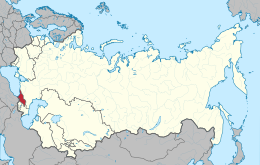Georgian Soviet Socialist Republic (1921–1991): Difference between revisions
More languages
More actions
(Coup) Tag: Visual edit |
No edit summary Tag: Visual edit |
||
| Line 8: | Line 8: | ||
In April 1953, shortly after Stalin's death, Beria organized a coup in Georgia to restore his supporters to power. [[Vladimir Dekanozov]] replaced [[Rukhadze]] as Georgia's [[MGB|Minister of State Security]]. | In April 1953, shortly after Stalin's death, Beria organized a coup in Georgia to restore his supporters to power. [[Vladimir Dekanozov]] replaced [[Rukhadze]] as Georgia's [[MGB|Minister of State Security]]. | ||
Generals [[Aleksei Antonov|Antonov]] and [[Sergei Yefimov]] organized another coup on 14 July 1953. They overthrew Beria's supporters installed [[Vasil Mzhavanadze]] as the leader of the CPG.<ref name=":02233232">{{Citation|author=Ludo Martens|year=1996|title=Another View of Stalin|chapter=From Stalin to Khrushchev|isbn=9782872620814|publisher=Editions EPO|pdf=https://gateway.ipfs.io/ipfs/bafykbzaceab64vxtxpqt2cdl4zsrsftmedqidn4foq74gr25qkd35z5nwogdi?filename=Ludo%20Martens%20-%20Another%20View%20of%20Stalin-Editions%20EPO%20%281996%29.pdf|page=261–262}}</ref> | Generals [[Aleksei Antonov|Antonov]] and [[Sergei Yefimov]] organized another coup on 14 July 1953 with [[Nikita Khrushchev|Khrushchev]]'s support. They overthrew Beria's supporters installed [[Vasil Mzhavanadze]] as the leader of the CPG.<ref name=":02233232">{{Citation|author=Ludo Martens|year=1996|title=Another View of Stalin|chapter=From Stalin to Khrushchev|isbn=9782872620814|publisher=Editions EPO|pdf=https://gateway.ipfs.io/ipfs/bafykbzaceab64vxtxpqt2cdl4zsrsftmedqidn4foq74gr25qkd35z5nwogdi?filename=Ludo%20Martens%20-%20Another%20View%20of%20Stalin-Editions%20EPO%20%281996%29.pdf|page=261–262}}</ref> | ||
== Economy == | |||
In 1971, there were 19,411 Georgian scientific workers, and Georgians were significantly overrepresented in scientific fields. Despite this, the average Georgian wage in 1978 was 16% below the all-union average.<ref name=":03">{{Citation|author=Albert Szymanski|year=1984|title=Human Rights in the Soviet Union|chapter=The Asian Nationalities in the USSR|page=44–59|pdf=https://cloudflare-ipfs.com/ipfs/bafykbzaceazdmtb2y3qq27fve5ib3gk7uv2unt6ae2xss74xmfpur7k5uhl5m?filename=Albert%20Szymanski%20-%20Human%20Rights%20in%20the%20Soviet%20Union_%20Including%20Comparisons%20with%20the%20U.S.A.-Zed%20Books%20Ltd.%20%281984%29.pdf|city=London|publisher=Zed Books Ltd.|isbn=0862320186|lg=https://libgen.rs/book/index.php?md5=C597B1232D9EA6B0F3DCB438D7E15A81}}</ref> | |||
== Demographics == | |||
Ethnic Georgians made up 68.8% of Georgia's population in 1979, a slight increase from 64.3% in 1959. The percentage of [[Russian Soviet Federative Socialist Republic (1917–1991)|Russians]] in Georgia dropped from 8.5% to 7.4% from 1970 to 1979. Georgians were overrepresented in the [[Communist Party of the Soviet Union|CPSU]] more than any other major nationality.<ref name=":03" /> | |||
=== Languages === | |||
73% of books and 86% of newspapers published in Georgia were in Georgian. 98.4% of ethnic Georgians spoke Georgian as their first language.<ref name=":03" /> | |||
== Living standards == | |||
=== Education === | |||
The number of students in Georgia rose from 157,000 before the [[Russian revolution of 1917|revolution]] to 975,000 in the late 1970s. The Georgian student/population ratio was 43% higher than the USSR average and the second highest for any nationality behind [[Judaism|Jews]].<ref name=":03" /> | |||
=== Health care === | |||
In 1959, the per capita health expenditure in Georgia was 17.7 rubles, which was higher than [[Kazakh Soviet Socialist Republic (1936–1991)|Kazakhstan]] or [[Uzbek Soviet Socialist Republic (1924–1991)|Uzbekistan]] but lower than Russia. In 1971, the number of doctors, 36.8 per 10,000 people, was higher in Georgia than in any part of the Soviet Union. However, the number of hospital beds (88.0 per 10,000) was the second lowest behind [[Armenian Soviet Socialist Republic (1920–1991)|Armenia]].<ref name=":03" /> | |||
== References == | == References == | ||
[[Category:Republics of the Soviet Union]] | [[Category:Republics of the Soviet Union]] | ||
Revision as of 19:43, 9 April 2023
| Georgian Soviet Socialist Republic საქართველოს საბჭოთა სოციალისტური რესპუბლიკა | |
|---|---|
 | |
| Capital and largest city | Tbilisi |
| Dominant mode of production | Socialism |
| Government | Soviet republic |
The Georgian Soviet Socialist Republic was a republic of the Soviet Union located in the southern Caucasus.
History
In 1951, Stalin purged several leaders of the Communist Party of Georgia for corruption and connections to U.S. imperialism. Beria's supporters, who made up more than half of the Central Committee, lost their positions.
In April 1953, shortly after Stalin's death, Beria organized a coup in Georgia to restore his supporters to power. Vladimir Dekanozov replaced Rukhadze as Georgia's Minister of State Security.
Generals Antonov and Sergei Yefimov organized another coup on 14 July 1953 with Khrushchev's support. They overthrew Beria's supporters installed Vasil Mzhavanadze as the leader of the CPG.[1]
Economy
In 1971, there were 19,411 Georgian scientific workers, and Georgians were significantly overrepresented in scientific fields. Despite this, the average Georgian wage in 1978 was 16% below the all-union average.[2]
Demographics
Ethnic Georgians made up 68.8% of Georgia's population in 1979, a slight increase from 64.3% in 1959. The percentage of Russians in Georgia dropped from 8.5% to 7.4% from 1970 to 1979. Georgians were overrepresented in the CPSU more than any other major nationality.[2]
Languages
73% of books and 86% of newspapers published in Georgia were in Georgian. 98.4% of ethnic Georgians spoke Georgian as their first language.[2]
Living standards
Education
The number of students in Georgia rose from 157,000 before the revolution to 975,000 in the late 1970s. The Georgian student/population ratio was 43% higher than the USSR average and the second highest for any nationality behind Jews.[2]
Health care
In 1959, the per capita health expenditure in Georgia was 17.7 rubles, which was higher than Kazakhstan or Uzbekistan but lower than Russia. In 1971, the number of doctors, 36.8 per 10,000 people, was higher in Georgia than in any part of the Soviet Union. However, the number of hospital beds (88.0 per 10,000) was the second lowest behind Armenia.[2]
References
- ↑ Ludo Martens (1996). Another View of Stalin: 'From Stalin to Khrushchev' (pp. 261–262). [PDF] Editions EPO. ISBN 9782872620814
- ↑ 2.0 2.1 2.2 2.3 2.4 Albert Szymanski (1984). Human Rights in the Soviet Union: 'The Asian Nationalities in the USSR' (pp. 44–59). [PDF] London: Zed Books Ltd.. ISBN 0862320186 [LG]


